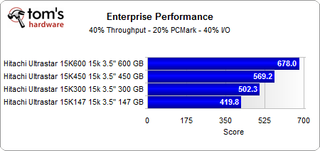3.5” Enterprise Hard Drive Development Analyzed
Benchmark Results: Efficiency And Performance Index, Conclusion

Our four hard drive generations show power efficiency doubling when it comes to sequential throughput. This is mainly because of much increased performance since power consumption levels did not change significantly. But it also has to be said that power is less of an issue for high-performance drives.

Efficiency with workstation I/O has improved, as well, but the advances are rather small compared to the streaming efficiency because of only small improvements in power consumption paired with equally small steps made in performance.

Our enterprise performance score is based on throughput and I/O performance. Application performance has only a small impact. As you can see, the score summarizes the performance advances pretty well.
Conclusion
The four Hitachi drives are almost identical when it comes to their dimensions and specifications, but in all other ways they’re substantially different, showing evolutionary performance advances from one generation and the next. Although power consumption levels don’t decrease very much in these enterprise drives, we still found that efficiency successively increased. The latest 3.5” SAS enterprise hard drives deliver much increased capacity, much increased performance, and slightly improved efficiency.
Capacity and performance are key on servers, but there is more to consider. Compliance and platform stability are very important in real life scenarios. Enterprise hard drives are one of the few components in server systems that sometimes get replaced. Validating a certain hard drive type against existing servers to deploy dozens or hundreds of them is certainly worth the effort.
Stay on the Cutting Edge
Join the experts who read Tom's Hardware for the inside track on enthusiast PC tech news — and have for over 25 years. We'll send breaking news and in-depth reviews of CPUs, GPUs, AI, maker hardware and more straight to your inbox.
Current page: Benchmark Results: Efficiency And Performance Index, Conclusion
Prev Page Benchmark Results: Temperature And Power ConsumptionMost Popular

